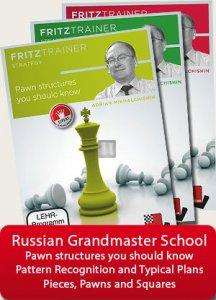Strategy University Vol 1,2,3,4,5 (22 ore di videocorso!) - DOWNLOAD
Mikhalchishin Adrian

Versione in download - 5 videolezioni, durata complessiva 22 ore!
Nato nel 1954 a Leopoli e Grande Maestro dal 1978, è attualmente tra i primi 5 allenatori mondiali e Presidente della Commissione Allenatori FIDE. L'ucraino ha allenato la squadra dell'URSS negli anni '80, le squadre nazionali di Slovenia, Polonia e Paesi Bassi, ed è stato l'allenatore di Anatoly Karpov (1980-1986), ha allenato anche Zsuzsa Polgar, Alexander Beliavsky, Maja Chiburdanidze, Arkadij Naiditsch e Vassily Ivanchuk.
Descrizione
STRATEGY UNIVERSITY VOL.1 - THE CENTRAL APPROACH
Il centro è la parte più importante del campo di battaglia. Negli scacchi studiamo i diversi tipi di centro, alcuni dei quali sono già stati trattati nel DVD ‘Winning Structures’. Ma nella letteratura scacchistica abbiamo una grave mancanza di materiale didattico sul ruolo del centro e sul potere dei pedoni e dei pezzi sul centro stesso. Ma soprattutto manca la cosa più importante: come cambiare la struttura centrale dei pedoni. Questa è davvero la conoscenza che contraddistingue i campioni.
Durata del video (in lingua inglese): 3 ore 50 min.
STRATEGY UNIVERSITY VOL.2 - PREVENTION AND PREPARATION IN CHESS
Il grande Aaron Nimzowitsch in un suo scritto affermò: “Né l’attacco né la difesa sono il cuore del gioco posizionale, ma la profilassi.” Essa consiste in misure profilattiche prese per contrastare le minacce tattiche e i piani strategici dell’avversario. Ma non pensate che la prevenzione dei piani del vostro avversario sia una tecnica puramente difensiva. Essa è semplicemente parte della preparazione del vostro piano! Questo tema, difficile ma molto importante, è trattato nel videocorso con l’aiuto di molti esempi, non solo classici ma anche moderni.
Durata del video (in lingua inglese): 3 ore 30 min.
STRATEGY UNIVERSITY VOL.3 - POSITIONAL PAWN SACRIFICE -
In chess we have certain aims - coordination and the activation of one’s own pieces. Sometimes we need a special little something to speed up one of these processes - a small material sacrifice, mainly a pawn or pawns. A dynamic pawn sacrifice is easy to see, as the idea is to get clear gains for the pawn. Positional pawn sacrifices are much more difficult, as their real purpose does not become clear immediately, but only during the development of the plan. There were famous masters of positional pawn sacrifices - Bronstein, Kasparov and Romanishin.
Video running time: 4 hrs 15 min.
STRATEGY UNIVERSITY VOL.4 - THE TECHNIQUE OF REALISING THE WIN
Great players of the past used to say – the most difficult thing in chess is to win won positions! Every player has such problems – those at the top of the tree and (especially) juniors. The correct technique consists of proper exchange methods and of the continuation of a correctly chosen plan; it is important not to change strategy after a small material gain. The video shows and explains instructive mistakes made when trying to make extra material or a positional advantage count and in addition it demonstrates the correct techniques as employed in classic games.
Video running time: 4 hours 37 min.
STRATEGY UNIVERSITY VOL.5 - THE TECHNIQUE OF REALISING THE WIN
The Soviet grandmaster Vladimir Simagin was one of the first to employ the typical exchange sacrifice: on one hand the Sicilian exchange sacrifice Rxc3, and on the other allowing the “exchange” of a rook on f8 against the white bishop on h6 in order to go on and achieve a superiority on the black squares.
Attacks by Tal are presented under “Bluffs”, but the theme has a much more allembracing heading, namely “drastically altering the course of a game”.
Anybody can carry out double attacks, but how do you bring about the positions in which they are possible? This theme, which is of course partly tactical in nature, is one of the most important ones which can lead to success in chess.
How to take on board the ideas of other players and then make use of them yourself.
Through his own games, the author shows how to recognise typical mistakes and study them with a view to avoiding them in the future. 6. To finish off, the video introduces some legendary Soviet players: Yuri Razuvaev, Vitaly Tseshkovsky, Oleg Dementiev and Viktor Zheliandinov.
Video running time: 5 hours 35 min.
System requirements: Pentium-Processor at 300 Mhz or higher, 64 MB RAM, Windows7, Windows Vista, Windows XP, DVD drive, mouse, soundcard
Informazioni
- Casa editrice ChessBase
- Codice S6349off
 Italiano
Italiano
 English
English


